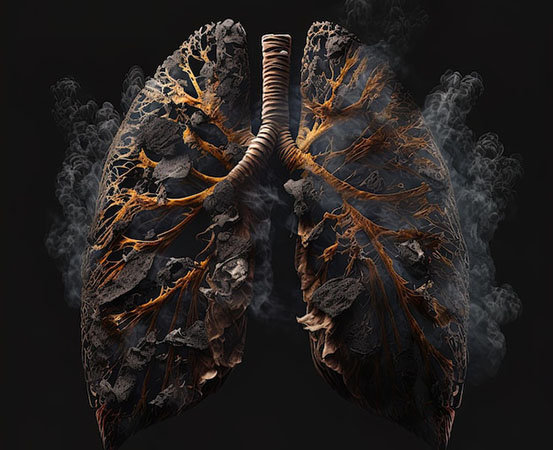
A diagnosis of black lung disease shook up the life of 45-year-old Niranjan (name changed on request) a couple of years ago. Until then, the coal mine worker from Jharkhand had always thought he was in robust health.
Niranjan had been in the mining profession for over two decades when he was diagnosed with the condition, which is also called coal workers’ pneumoconiosis or coal miner’s lung.
Niranjan’s troubles began with persistent cough. When the cough stayed for over six months, he grew increasingly worried about his health. Gradually he began experiencing breathlessness and fatigue. All attempts to curb the cough with medications failed.
The persistent symptoms prompted him to undergo a chest X-ray, which showed mottling or nodules in the lungs, confirming the diagnosis.
“Niranjan went on to develop tuberculosis, which is seen in 30% of people with black lungs as their immunity takes a hit,” says Dr Tapan Kumar Mohanty, a senior chest physician at Meditrina Hospital, Jamshedpur, Jharkhand, who treated Niranjan.
While the tuberculosis was managed with antituberculosis medicine, Niranjan was given symptomatic treatment for his black lungs involving mucous-clearing agents. He was also put on oxygen support to aid his breathing.
What is black lung?
“Black lung is an occupational lung condition mostly seen among coal miners,” says Dr Mihir Gangakhedkar, consultant pulmonologist, Fortis Hospital, Mumbai. “Coal miners are exposed to coal dust which can enter the lungs on inhalation. The lungs produce an inflammatory response, a protective mechanism to expel these particles.”
According to Dr Sunil Kumar K, lead consultant, interventional pulmonology, Aster CMI Hospital, Bengaluru, particles larger than five microns get filtered in the nose itself. “Those less than five microns get filtered by the lungs and expelled as phlegm,” he says. “When the exposure exceeds the lung’s ability to remove these particles, they start accumulating, forming nodules in the lungs.”
Lungs: from pink to black
Dr Sunil adds that chronic inflammation due to continuous exposure to coal particles can cause scarring of the lungs, which impairs lung functioning. “The coal particles depositing on the lungs give the lungs a black appearance,” he says, adding that black lung doesn’t happen immediately but over at least 10 years of sustained exposure.
“Coal workers’ pneumoconiosis is one of the three types of pneumoconiosis, which are lung diseases caused by continued dust inhalation,” says Dr Mohanty. “The other two types are silicosis (caused by inhaling silica dust) and asbestosis (caused by inhaling asbestos fibres).”
Symptoms of black lung disease
According to Dr Gangakhedkar, not everyone exposed to coal dust develops black lung disease. In those with the condition, the severity of symptoms may vary.
“While some experience cough, breathlessness on exertion and chest tightness, some show no symptoms until the condition has progressed,” he says. “Eventually black lung disease can progress to cause breathlessness even in the absence of exertion and can lead to respiratory failure.”
Black lung disease can also cause heart failure as lung fibrosis tends to increase the blood pressure of the artery that carries blood from the heart to the lungs, causing the heart to expand.
Coughing out blackish particles, which is called melanoptysis, is also seen.
“Eight to 10% of people with coal miner’s lung also test positive for autoimmune disorders,” adds Dr Gangakhedkar.
Smoking and the risk of black lungs
“Smoking, along with a coal mining job, increases your susceptibility to black lung disease,” says Dr Sunil.
According to Dr Gangakhedkar, underlying conditions like asthma can worsen the symptoms. “Controlling asthma and curbing smoking are important to manage the condition,” he says.
Treatment for coal workers’ pneumoconiosis
According to Dr Mohanty, there is no specific treatment for black lungs. So, treatment mostly revolves around managing the symptoms.
Primarily, those with the condition should avoid exposure. If there is a chronic cough, it needs to be managed with bronchodilators and cough suppressants.
“Inhalers can be taken if [the affected person is] allergic — that is, coughs only on exposure to coal particles,” says Dr Mohanty. “In [case of] advanced respiratory failure, oxygen support may be required.”
Dr Mohanty also mentions pulmonary rehabilitation, a programme to help people with lung conditions breath better through exercises and breathing techniques.
“As scarred lungs are predisposed to developing infections frequently, routine vaccinations are recommended,” says Dr Sunil. “Lung transplantation is also done in rare cases if someone is extremely dependent on oxygen support.”
Preventing black lung disease
Dr Gangakhedkar lists some preventive measures:
- Primary prevention involves measures to prevent the disease and methods to reduce exposure to coal mine dust.
- Coal mines must have dust-control techniques and dust-sampling procedures to gauge dust levels.
- Rotation of workers from high-exposure to low-exposure areas to prevent sustained exposure.
- Using personal protective equipment like respirators.
- Secondary prevention involves early detection of the condition – for example, by annual screening (X-ray, pulmonary function test, etc) of workers. People receiving a diagnosis are sent for further treatment.
- Tertiary prevention involves the management of complications and improving the quality of life with medications, oxygen support and pulmonary rehabilitation.
Takeaways
- Black lung is caused by prolonged coal dust exposure. It is mostly seen among coal workers.
- Accumulation of coal dust in the lungs causes inflammation and scarring.
- Coal workers’ pneumoconiosis causes breathlessness, chest tightness and cough.
- Treatment involves managing symptoms and oxygen support (in advanced cases).

















